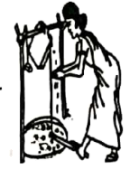1 . Earthquake rescue robots have experienced their final tests in Beijing. Their designers say with these robots, rescuers will be able to save lives during an earthquake. This robot looking like a helicopter, is called the detector-bot. It’s about 4 meters long, and it took about 4 years to develop the model. Its main functions (作用) are to collect information from the air, and send goods of up to 30 kilos, to people trapped by an earthquake.
This robot has a high definition 360 degree panoramic (全景) camera. It can work day and night and will also be able to send the latest pictures from the quake area.
Dr. Qi Juntong, Chinese Academy of Science, said, “The most important feature of this robot is that it doesn’t need a distant control. We just set the destination (目的地) information on it, and then it takes off, and lands by itself. It flies as high as 3,000 meters, and as fast as 100 kilometers per hour.”
This robot has a different function — it can change as the environment changes. Its main job is to search for any signs of life in places where human rescuers are unable to go.
As well as a detector (探测器) that finds victims and detects poisonous gas, a camera is placed in the 40 centimeter long robot, which can work in the dark.
Another use for the rescuers is the supply part, with its 10 meter long pipe. People who are trapped in the ruins, will be able to get supplies including oxygen and liquids.
Experts have said that the robots will enter production, and serve as part of the national earth-quake rescue team as soon as next year.
1. According to the passage, this robot________.| A.is carried by the helicopter | B.weighs about 30 kilos |
| C.is a machine with a length of 10 meters | D.hasn’t been put into production so far |
| A.a camera | B.a robot | C.a rescuer | D.a detector |
| A.It is designed to prevent the earthquake. | B.It is unable to send goods. |
| C.It can take and send pictures even in the dark. | D.It can be used to take in poisonous gas. |
| A.what the robot looks like | B.an introduction to the robot |
| C.how the robot is made | D.information about earthquakes |
2 . Tourist Guide to the National Gallery
Opening hours: Daily 10: 00 am- -6: 00 pm; Friday 10: 00 am- 9: 00 pm
Closed: 2426 December
Reasons to visit:
With over 2, 300 paintings in the collection, there are hundreds of reasons to visit the Gallery. Here are some to get you started...
Get into great art. From Leonardo da Vinci to Vincent van Gogh: See priceless works of art for free.
Get creative. Brush up your skills, and create your own great works of art...
Learn about art. Discover more about paintings...
Regulations:
Talk in a low voice when you use your cellphone in the gallery
Please do not touch the paintings or other exhibits. Do not take pets in or cross the barriers.
Consume food and drink in designated areas only i.e. not in rooms that contain paintings.
Follow our no smoking policy in any part of the building.
Follow our no photograph policy in exhibitions where a sign is displayed.
Access:
The National Gallery aims to make access to the paintings enjoyable and welcoming to the widest possible public. There are a range of facilities to help you see the collection, visit exhibitions and come to events.
The Gallery offers British Sign Language-interpreted talks on paintings for visitors who are deaf, and special art sessions(展期) for visitors who can't see.
Address: The National Gallery, Trafalgar Square London WC2N 5DN
Click here to find more information.
1. What are visitors allowed to do in the National Gallery?| A.Make a phone call. | B.Take a dog in. |
| C.Smoke a cigarette. | D.Take photos. |
| A.Young visitors. | B.Deaf visitors. |
| C.Blind visitors. | D.Old visitors. |
| A.In a newspaper. | B.On a poster. |
| C.In a magazine. | D.On the Internet. |
3 . For several months, Cara has been working up the courage to approach her mom about what she saw on Instagram. Not long ago, the 11yearold girl, like all the other kids in this story, discovered that her mom had been posting her photos for much of her life. “I’ve wanted to bring it up. It’s strange to see myself up there, and sometimes there are pictures I don’t like of myself, ”she said.
Like most other modern kids, Cara grew up immersed(沉迷…之中) in social media. While many kids may not yet have accounts themselves, their parents, schools, sports teams, and organizations have been organizing an online presence for them since birth. The shock of realizing that details about your life have been shared online without your permission or knowledge has become an important experience in the lives of many teenagers. Recently a parenting blogger(博主) wrote in a Washington Post essay(散文) that despite(不顾) her 14yearold daughter’s horror at discovering that her mother had shared years of highly personal stories and information about her online, she simply could not stop posting on her blog and social media. The writer said that promising her daughter that she would stop posting her publicly on the Internet would mean shutting down a vital part of herself, which isn’t necessarily good for herself or her daughter.
But it’s not just crazy mommy bloggers who construct a child’s online identity; plenty of average parents do the same. There’s even a special word for it: sharenting. Almost a quarter of children begin their digital lives when parents upload their photos to the Internet, according to a study conducted by the Internetsecurity firm AVG. The study also found that 92 percent of kids under the age of 2 already have their own unique digital identity.
1. How does Cara feel about her mom’s behavior?| A.It’s aggressive. | B.It’s appropriate. |
| C.It’s annoying. | D.It’s favorable. |
| A.Because it filled up her blog. | B.Because it showed off her success. |
| C.Because it recorded her stories. | D.Because it meant a lot to her. |
| A.A quarter of students. | B.Most ordinary parents. |
| C.Kids under the age of 2. | D.Some crazy bloggers. |
| A.Children’s New Trouble | B.Social Media |
| C.Kids’ Online Performance | D.Mommy Bloggers |
4 . Every kid has their own obsessions (着迷的事情). Dolls, dinosaurs, remote controls, cell phones—they might have a toy box with a wide range of playthings to keep them entertained, but there’s a firm favorite they always reach for first.
Researchers call this phenomenon “extremely intense interests (Ells)”, and have found that they start to emerge at around 18 months of age and are evident in around a third of preschool-aged children. For lots of children, this obsession revolves around (围绕) cars. And although the sex divide in the toy world remains, it’s not only little boy who are drawn to all things with wheels. So what’s the big deal about cars, trucks, trains, and buses?
From age 0-2, children are the sensorimotor stage of development. They are learning by absorbing everything through their senses—sight, touch, taste, smell, hear. Toys and real-life objects like cars are very sensorily engaging. Kids can interact with toy cars, trucks, etc. through spinning their wheels, watching them move in a variety of direction, or hearing the sounds they make.
Plus, kids are just naturally drawn to loud, moving objects. They see the lights on the cars, the rolling wheels, the sound of the engine. Kids will always be drawn to flashy and loud things because that is what engages their brain and sensory systems. Another appeal of toy vehicles is that they’re typically small enough to fit in a child’s hand. And because they can put their cars in their pocket or carry them around, they’re easy to get attached to.
Every child is unique in how they engage with toys, and the reasons for their play style may be diverse and complex. However children often interact with materials in similar ways to how their families interact with them. If a child sees a sibling or parents modeling play with a car going fast down a track, they are likely going to interact with the toy that same way. Ultimately, how your kids play with their toy vehicles could be a little window into what excites them.
1. What do we know about the kid’s obsession?| A.Girls may like playthings with wheels as the boys do. |
| B.Kids keep what they are obsessed with within their reach. |
| C.Kids’ obsession with cars begin earlier and it lasts long. |
| D.EIIs promotes the interest of children in all things with wheels. |
| A.They are flashy and attractive. |
| B.They are convenient to carry in children’s hands. |
| C.They are easy for children to get attached to. |
| D.They exercise children’s brain and sensory system. |
| A.Parents should teach the kids how to play with toy vehicles. |
| B.It is helpful to know the way of kids playing with toy vehicles. |
| C.Siblings should always play with their younger brothers or sisters. |
| D.Children are different from each others in choosing the toys vehicles. |
| A.To advertise toy cars. | B.To introduce appealing toys. |
| C.To explain reasons kids like toy cars. | D.To encourage parents to interact with kids. |
5 . The summer before my 10th birthday my father and mother moved our family of nine children to a farm! We had always lived in a small city, in the house my dad bought from my grandparents. But he wanted fresh air, healthy food and lots of room for his children to play. He'd worked multiple jobs at a time and saved for many years…and could finally afford a place in the countryside. Now a minor concern: the house had no running water or electricity. But there were 150 acres to run around in, walk through the woods in, swim a stream in, and otherwise yell, sing and laugh in every day!
That first year my dad put in electricity, because my mom simply announced, “I won't have kerosene lamps with children running around!” Indoor plumbing had to wait another year(an outhouse came with the property). Different friends, who my dad knew from work, asked if he'd take their large dogs who couldn't run free in the city. So we all now played with a big orange-brown boxer and a sporty German Shorthaired Pointer, who we simply named Billy and Molly. Absolutely all our clothes were hand-me-downs, bananas and oranges were “exotic” fruit that we'd see at holidays, and there was ONE birthday party a year! We'd take turns once every 10 years a child would have his/ her own party!
We thought we were rich. My mother was always singing, yelling hugging, or praying. And she told us we were blessed with plenty! To this day, each of my brothers and sisters remember those years as an abundance of chores, laughter, arguing, making peace, and playing together! Every challenge was a game aimed to outwit, and any failure was chance to learn. Money was so scarce, but joy was everywhere.
1. Why did the author's family move to a farm?| A.They had to work on the 150-acre farm. |
| B.They couldn't afford the house in the city. |
| C.They succeeded to a house from grandparents. |
| D.They believed living there was beneficial to them. |
| A.Their life was more comfortable. | B.Their house was short of space. |
| C.Their dogs are quieter than the author's. | D.They greatly envied the author’s father. |
| A.Prepare. | B.Win. | C.Manage. | D.Avoid. |
| A.Simple but happy. | B.Wealthy and cheerful. |
| C.Poor and misery. | D.Rich but disappointed. |
6 . Toronto Wildlife Centre’s rescue team wants to match their expert skill with the latest technology to help more animals.
The rescue team wants to help animals fast and with an even higher success rate. They are looking at technology ranging from as simple as a quick-firing netgun to as complex as a remotely controlled trail camera that is connected to the cellular network. This would immediately inform them with a photo if an animal has been successfully trapped, or has returned to a site that they are monitoring.
A small thermal imager (热像仪) is another piece of equipment that the rescue team is looking at to add to their tool box. The technology would allow the rescuers to see an animal’s heat signature. This would be useful for finding animals hidden in brush, rescuing wildlife stuck inside buildings, or finding animals at night when it’s too dark to see. Say we know there’s an injured animal in a back yard with many hiding spots. We don’t want to storm there and scare him away. We want to be able to predict his movement and rescue him as effectively as possible and the only way we can do that is by knowing where he is, the rescue team leader, Andrew Wight said.
The team also has their eye on a camera-equipped drone (无人驾驶飞机). “We want to use drones for aerial (空中的) watching in situations like when we have a baby bird that came from a nest that is difficult to access. If there’s no other baby in the nest, we can build a new nest, and the parents will simply find their baby and relocate to the new nest. If there’s another baby in the nest, we can’t separate the family and will need to return the baby to the original one. If we have a camera-equipped drone, we will easily see if there are any other babies in the original nest and plan accordingly,” Andrew explained.
1. What can we learn from paragraph 2?| A.The rescue team aims to simplify the technologies. |
| B.The remotely controlled trail camera is used to trap animals. |
| C.The remotely controlled trail camera must have internet access. |
| D.The rescuers will receive a photo only when an animal is trapped. |
| A.By providing enough light at night. |
| B.By showing the location of the animal. |
| C.By giving off heat to warm the animal. |
| D.By offering a way to hide the rescuers. |
| A.The bird nest would be destroyed. | B.The baby bird would be deserted. |
| C.The rescue work would be difficult. | D.Another nest would have to be built. |
| A.Rescuing Animals with Technology | B.Toronto Wildlife Centre |
| C.Fast Developing Technology | D.Ways to Protect Wildlife |
7 . 90-Second Newbery Film Festival
The 90-Second Newbery Film Festival is a yearly video contest in which young filmmakers create short movies that tell the entire stories of Newbery award-winning books in about a minute and a half.
Who can make movies for this film festival? It's a big range:elementary school kids, junior high school students, high school students, even college students.
We show the best movies we receive at special-event screenings in many cities.
Here are the rules:
Your video should be about 90 seconds.
Your video has to be about the story in a Newbery award-winning book.
We're looking for full-on movies with mostly child actors, who manage to tell the entire story of the book in 90 seconds.
Upload your videos to any video website and send us the link.
Sending the link to us gives us the right to post it on our blog and to other websites where we sometimes post content.
The general deadline for the tenth annual 90-Second Newbery Film Festival is January 15, 2021.
Don't know where to start? Check out our Video Resources page here for a step-by-step primer on how to make a 90-Second Newbery video, plus lots of other tips, tricks, and tutorials(教程).
1. Who can take part in the contest?
| A.Anyone. | B.Only adults | C.Students. | D.Professionals. |
| A.The film is starred by child actors. | B.The film is sent on December 31, 2020. |
| C.The film is about the history of Newbery Award. | D.The copy of the film is sent to a small video website. |
| A.On a website. | B.On the school board | C.In a magazine. | D.In a newspaper. |
8 . The Chinese brake fern (蜈蚣草) — which is native to Asia, southern Europe, Africa and Australia — has a unique ability: It can take in high quantities of arsenic (砷), a harmful heavy metal, from the soil and store it without dying.
Now, a team of scientists from Purdue University has finally unlocked the secrets of how the plant is able to do this. The findings could have important significance because soil and groundwater polluted with arsenic are a potential risk to hundreds of millions of people around the world.
Currently, cleaning up the toxic (有毒的) metal is a laborious and very expensive process. However, the scientists hope that the Chinese brake fern could hold the key to a more effective solution.
“Other researchers have shown that this fern, when grown on arsenic-polluted soil, can remove almost 50 percent of the arsenic in five years,”said lead researcher Jody Banks in a statement.“It takes time, but it's cheap.”
Furthermore, the team said that the new findings could one day be used to genetically (从基因方面) engineer other plants to suck up the toxic metal from the soil, and they should work more quickly and effectively than the Chinese brake fern, thus providing a solution that could potentially reduce the cost and time of arsenic cleanup.
In general, arsenic is toxic to plants and animals due to the fact that it can cause cell death by disturbing a cell's ability to produce ATP, which acts as an energy source. The Chinese brake fern, however, is quite able to prevent the process from occurring, researchers said.
The team identified three genes that exhibit significant activity when the plant comes into contact (接触) with arsenic. When the scientists “turned off”these genes in experiments, they found that the plant died, stressing their importance in protecting against arsenic's toxic effects.
1. What is special about the Chinese brake fern?| A.It can prevent the production of ATP. |
| B.It can be a new source of metal. |
| C.It can only be found in China. |
| D.It can absorb arsenic from the soil. |
| A.To prove the acute poisonousness of arsenic. |
| B.To stress the significance of their new study. |
| C.To show a cheap method of removing arsenic. |
| D.To explain the need to clean up arsenic-polluted water. |
| A.By creating arsenic-resistant soil. |
| B.By improving the Chinese brake fern. |
| C.By changing the characteristics of arsenic. |
| D.By making other plants clean up arsenic. |
| A.They got them to stop working. |
| B.They separated them from the plant. |
| C.They compared them with other genes. |
| D.They observed their functions separately. |
9 . Handwashing is one of the easiest ways to protect against disease, but lack of running water is a problem for 3 billion people in the world, according to the World Health Organization(WHO) and UNICEF, the United Nations Children's Fund. Tippy taps are one way. Sometimes, the little things make such a big difference. These low-cost handwashing stations are helping people stay healthy.
There are different ways to build and use tippy taps. But the basic tools include a plastic water bottle, sticks, and rope. Hang the bottle from a branch or pole. Press a foot pedal to tip the bottle and release water. Then wet your hands and scrub with soap for at least 20 seconds. Done!
In Uganda, Faridah Luanda has been teaching her neighbors how to make tippy laps. Washing hands is very difficult in her neighborhood because they don't have access to washing facilities. When COVID-19 started and people were told to clean their hands frequently, they needed to be creative. Luanda and her neighbors have set up 800 tippy taps in the community. “We are helping ourselves,” Luanda says “Children, people with disabilities, and other vulnerable people—they cannot be left behind.”
In Guatemala, people have set up nearly 400 tippy laps. Each cost about $12 to make.
Tippy taps are also being used in the United States. Kids from the Lake & Park School, in Seattle Washington, heard about the project. They raised $4,000 to support it. In Tucson, Arizona, they' re helping the homeless. Two were set up at a shelter called Sister Jose Women’s Center. COVID-19 forced the shelter to close. But workers continued to give out food. They needed a way to let people wash their hands before eating. The tippy tap is such a simple solution.
1. What does the author think of tippy taps?| A.They are invented by the WHO | B.They can ease the water shortage. |
| C.They are money-saving and effective. | D.They are too expensive to popularize. |
A. | B. | C. | D. |
| A.Lazy. | B.Weak | C.Dirty. | D.Foolish. |
| A.The homeless. | B.The school children. |
| C.The volunteer workers. | D.The patients in hospital. |
10 . The idea of using a public bathroom with see through walls may sound like the stuff of nightmares. But a famous Japanese is hoping to change that view, using new technology to make restrooms in Tokyo parks more inviting.
“There are two things we worry about when entering a public restroom, especially those cated at a park,” according to architect Shigeru Ban’s firm. “The first is cleanliness, and the second is whether anyone is inside.”
The newly-invented transparent walls can turn off both of those worries, Ban says, by showing people what awaits them inside. After users enter the restroom and lock the door, the room’s walls turn a powdery paste) shade and are no longer see-through.
Ban’s are sure to make for great conversation among visitors to the park-and they’ll stand out even more after dark. “At night, the facility lights up the park like a beautiful lantern,” the architect’s website says.
The group is behind the Tokyo Toilet project, world-famous architects to create toilets “like you’ve never seen. The project’s eye catching toilets are part of a plan to put people ar ease when isiting a public bathroom. The project may seem silly, but the 16 architects who are reimagining public toilets are some of the brightest names in Japanese architecture. The list includes four Pritzker Prize winners-Ban, Toyo Ito, Tadao Ando and Fumihiko Maki-along with international stars such as Kengo Kuma and Sou Fujimoto. The fashion designer Nigo is also contributing.
Ban’s colorful public bathrooms opened to the public this month in two parks: Yoyogi Fukamachi Mini Park and Haru-no-Ogawa Community Park. Other bespoke commodes will be opening in coming months.
1. Why are people often worried before entering a public restroom?| A.Its lock is usually useless. |
| B.It’s usually at a huge distance. |
| C.It’s not always clean. |
| D.It’s always occupied. |
| A.Easy to see through. |
| B.Not easy to see through. |
| C.Full of bright colors. |
| D.Thick and strong. |
| A.It’s and silly. |
| B.It’s rewarding and. |
| C.It has won the Pritzker Prize. |
| D.It’s the fruit of colleqtive wisdom |
| A.Should the public restrooms be upgraded? |
| B.The new high-tech walls of public restrooms are coming. |
| C.How do we live with see-through public facilities? |
| D.Some famous architects designed a silly project. |



